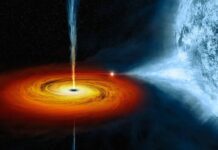Ever thought Jupiter was the only drama queen with its gigantic storm, the Great Red Spot? Think again! Saturn is stepping into the limelight with some stormy behavior of its own. It turns out, Saturn hosts century-long megastorms that make Earth’s hurricanes look like mere drizzles.
Previously, Jupiter stole all the attention with its iconic Great Red Spot, leaving Saturn as the “calmer” sibling. Not anymore. Even if Jupiter’s storm still holds the record as the largest, Saturn’s storms are no joke.
The frequency of Saturn’s megastorms? Every 20 to 30 years. These storms are kind of like our hurricanes, but on steroids. But here’s the twist: while our hurricanes are powered by the oceans, Saturn’s storms run on some mysterious mojo, given that its atmosphere is mainly hydrogen and helium.
A team of clever astronomers from the University of California, Berkeley and the University of Michigan, Ann Arbor are on the case. They’ve been peeking into Saturn’s atmosphere by studying changes in its ammonia gas distribution. Their secret weapon? The Karl G. Jansky Very Large Array (VLA) in New Mexico, a kind of super-powered radio telescope.
Why radio waves? Good question! Radio waves help them see beyond the visible cloud layers on Saturn. It’s like having X-ray vision for planets! By looking deeper, they can understand the chemistry and processes behind cloud formation and heat transfer.
The results? Saturn’s radio waves showed strange ammonia patterns that pointed straight to past megastorms. Think of it like storm fingerprints! In particular, there was a drop in ammonia in the middle latitudes, indicating a thick ammonia ice-cloud layer above. Dive deeper, about 100 to 200 kilometers, and voila – ammonia concentrations surge! This suggests that these megastorms create a kind of ammonia rain, an effect that can hang around for centuries.
What’s even cooler? Saturn’s storm-driven atmospheric layers are unique. Jupiter, even with its similarities to Saturn, doesn’t display such features. It’s like finding out two twins have wildly different personalities. This discovery is a game-changer; it teaches us that even neighboring gas giants in the same solar system can have stark contrasts.
And for those scientists scouting other gas giants outside our solar system, this Saturn revelation might just be their new playbook.


















![10 Countries With the Best Healthcare in the World [Statistical Analysis] Countries With the Best Healthcare in the World](https://articleify.com/wp-content/uploads/2025/07/Countries-With-the-Best-Healthcare-in-the-World-1-150x150.jpg)










